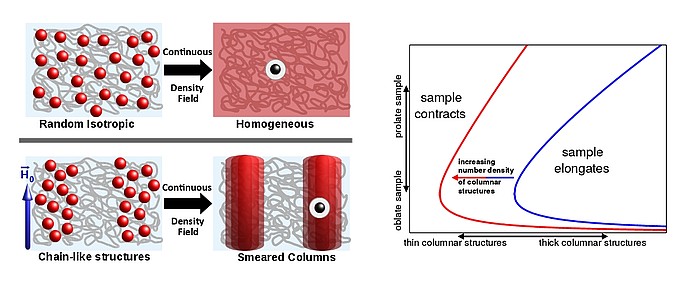Mechanical Properties of Magneto-Sensitive Elastomers
Collaborators
Dirk Romeis, Sanket Vijay Chougale, Mehran Roghani and Vladimir Toshchevikov
Introduction
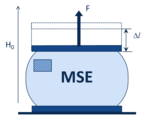
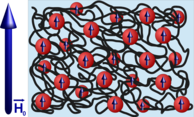
Magneto-sensitive elastomers (MSEs) are smart materials whose mechanical properties can be controlled by application of an external magnetic field. This makes them very attractive for a variety of technical implementations, especially for actoric applications such as artificial muscles, sensors, micro-robots and micro-pumps. MSEs represent a two-component system, in which micron-sized magnetizable particles are embedded in a polymer network. Further development of MSEs will greatly profit from the accurate theoretical prediction of such mechanical properties as equilibrium elongation, Youngs modulus, shear modulus and frequency dependences of the storage and loss moduli. To this aim, we develop versatile microscopic approaches which allow prediction of the static and dynamic mechanical behaviour of MSEs with different sample shapes and particle microstructures.
Cooperation:
Static Mechanical Properties and Elastic Coupling
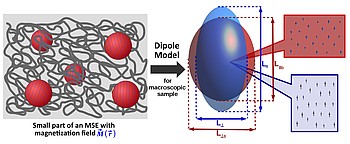
Upon applying a uniform magnetic field the changes in the mechanical behavior of MSEs primarily depend on three factors: the initial shape of the macroscopic sample, the initial microscopic particle distribution and the mechanism of the local particle rearrangement. Since the exact magnetization field is rather complicated to calculate, it is common to asign each particle an individual dipole moment. Based on this dipole-dipole interaction model we develop different theoretical formalisms to understand the mechanical behaviour of MSEs. We found conditions at which the total magnetic field inside the MSE can be split into two contributions: one which depends on the macroscopic sample shape and the other which depends on the microscopic particle distribution. This allows us to combine macroscopic continuum-mechanics and microscopic approaches for a complex analysis of the behavior of MSEs as a non-trivial interplay between sample shape, particle distribution and the presumed mechanism of particle rearrangement. Modelling the particle structures via continuous density fields (see figure below) we worked out a self-consistent model with locally varying magnetization fields and predict the sign of magneto-induced deformation. Different types of elastic coupling between the particle distribution and the deformation state were considered: strong affine coupling, absence of any elastic coupling and non-affine coupling to account for magnetically-induced chain-like particle structures. The results will be further used to develop an effective material model for MSEs in uniform magnetic field.
Dynamic-Mechanical Properties
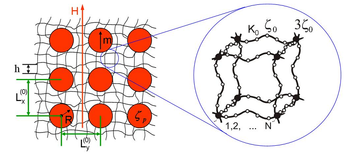
We develop the viscoelastic model for description of dynamic mechanical properties of isotropic and anisotropic MSEs in a uniform magnetic field. A microscopic approach proposed previously for studies of static mechanical properties of the MSEs is modified to the dynamic regime. Different spatial arrangements of magnetic particles are considered: isotropic as well as anisotropic chain-like and plane-like distributions with different degree of irregularity. Isotropic distributions are represented as particle arrangements on the simple cubic, body-centered cubic, hexagonal lattices and as purely stochastic distributions. This allows to study in great detail dynamic mechanical behaviour of MSEs in the intermediate- and low-frequency regimes depending on the particle arrangement inside an MSE.
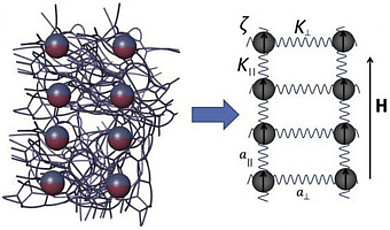
Recent Publications:
- S. Chougale, D. Romeis, M. Saphiannikova
Transverse isotropy in magnetoactive elastomers.
Journal of Magnetism and Magnetic Materials 523 (2021) 167597 - P. Metsch, D. Romeis, K.A. Kalina, A. Raßloff, M. Saphiannikova, M. Kästner
Magneto-Mechanical Coupling in Magneto-Active Elastomers.
Materials 14 (2021) 434 - D. Romeis, S.A. Kostrov, E.Yu. Kramarenko, G.V. Stepanov, M. Shamonin, M. Saphiannikova
Magnetic-field-induced stress in confined magnetoactive elastomers.
Soft Matter 16 (2020) 9047-9058 - D. Romeis, V. Toshchevikov, M. Saphiannikova
Effects of local rearrangement of magnetic particles on deformation in magneto-sensitive elastomers.
Soft Matter 15 (2019) 3552-3564 - D. Ivaneyko, V. Toshchevikov, M. Saphiannikova
Dynamic-mechanical behaviour of anisotropic magneto-sensitive elastomers.
Polymer 147 (2018) 95-107 - D. Romeis, P. Metsch, M. Kästner, M. Saphiannikova
Theoretical models for magneto-sensitive elastomers: A comparison between continuum and dipole approaches.
Physical Review E 95 (2017) ID042501 - D. Romeis, V. Toshchevikov, M. Saphiannikova
Elongated micro-structures in magneto-sensitive elastomers: A dipolar mean field model.
Soft Matter 12 (2016) 9364-9376


